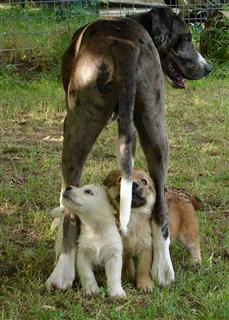The “ABC” of Vital Signs:
- Airway - can the dog breath - or is its airway blocked? If the airway’s blocked, then all the artificial respiration in the world is going to be pointless unless its lungs are full of water. It could, however, be blocked by seaweed, mud, sand, stones, a lump of bone, a ball and a whole variety of nasty things - so we need to unblock it.
Most things can be removed by using your fingers - or in the case of small items at the back of the throat - using pliers. Larger items - like a ball - need a bit more care to avoid wedging it in. Go to the outside of the throat - underside - place a finger at the base of the jaw - push firmly upwards and forward behind the object - toward the nose.
- Breathing - can you hear it breathing? With the dog lying stretched out on its side, can you see any signs of any gentle “rise and fall” of the chest - no? - then check.
- Circulation - is the heart beating? To find out - place your fingers on the lower part of the chest wall - left side - just behind the left front leg. You might have to search about a bit, but it’s there somewhere. Try it tonight...(hint...it’s easier if the dog’s lying down, flat on its side - not in that “please rub my tummy!” position).

|
|
Artificial Respiration:
- With the dog lying flat on its side - in the case of drowning, with its head lower than its body - kneel - with your knees almost up against its back.
- Remove its collar and stretch the neck forward.
- Place both hands over its rib cage and apply “fairly firm and positive” downward pressure - and release immediately.
- Count very slowly to 5 - and keep repeating - again and again.
- Apart from regularly checking your “ABC” - this can be kept up - all the way to the Vet’s surgery.
Recognising “Shock” - and coping with it:
Symptoms:
- Unusually rapid breathing / panting at over 30 breaths a minute... and / or
- Its paws feel cold - and it’s trembling or shivering......................... and / or
- It appears weak, listless - “definitely prefers” to lie down.............. and / or
- You’ve absolutely any reason to suspect that it might be suffering from shock, then be “on the safe side” and give it the full treatment.
Treatment:
- Having treated any injury - if it’s wet - gently dry it off.
- Let it lie down - somewhere warm and dry.
- If it won’t move - try to get a dry, warm blanket underneath it - and then wrap it over it’s body - a “hand warm” hot water bottle may be useful.
- If it wants to drink - providing it hasn’t been vomiting - small amounts of “warm” lightly sweetened milk or water are good.
- “Get to a Vet” as soon as possible.
Burns and Scalds:
- “Cool” water - and plenty of it - sprayed, sponged or gently poured over the affected area for about 5 - 10 minutes.
- Be prepared to treat for shock.
- “Get to a Vet” as soon as possible.
Electrical shock and burns:
- FIRST - switch “off” any electrical supply.
- Check your “ABC”.
- Treat the burns.
- “Get to a Vet” as soon as possible.
Heatstroke:
- Check your “ABC”.
- “Cool” water - and plenty of it - sprayed, sponged or gently poured over the dog for about 5 - 10 minutes - no more.
- Allow it to rest in a cool place - with plenty of drinking water.
- “Get to a Vet” as soon as possible.
Bee and Wasp stings:
are painful but generally fairly harmless on the body or limbs. Granny’s old favourite of ...“Bi-carb for bees and vinegar for wasps” ... works and greatly reduces the irritation. The problems start with stings inside the mouth - particularly the tongue - which can swell and cause serious breathing problems - “Get to a Vet”.
Beach tar / Oil / Diesel oil:
all known to be highly toxic to dogs. Don’t let it lick the area. Wash off with mild washing-up liquid - or “Swarfega” - and rinse thoroughly.
Bloat:
as the name suggests, is a sudden build up of gasses in a dog’s stomach. The dog appears “bloated” and is in obvious distress. It’s serious - “Get to a Vet”.
Snake bites:
the use of tourniquets for this is definately “frowned upon” these days. It’s better, if possible, to immobilise the limb - even using splints - and carry - or slowly and gently - walk the dog to the car and ...... “Get to a Vet”.
For the vast majority of other accidents, the first-aid treatment is the same as in the case of humans - with one - very notable exception ........
Road Traffic Accident:
A dog’s walking along the road - off the lead - sees something interesting on the other side - goes to investigate - gets hit by a car - and now we have .....
- A dog owner - probably hysterical - an injured dog - that’s in “shock” - frightened and needing medical attention - but first you have to ... “Catch your patient”
- Stay calm - and persuade those around you to either stay calm - or leave the scene.
- Three things that you’re going to need .... lead - muzzle - stretcher.
Not many of us carry all these things around with us - at least not muzzles or stretchers - so you’re going to have to improvise ....
- Lead - does the owner have one? ..... a trouser belt (not yours!), a length of rope, scarf, neck-tie, dress belt, ... even a long sleeve shirt ... anything that you can roll up and tie a knot in - in the case of a long sleeve shirt - one “arm” would probably do!
- Muzzle - a trouser belt, long sock, stocking / pair of tights, dress belt, scarf .... etc:
- Stretcher - a blanket, large overcoat, door - and three other “heroes” - to carry it.
- By now, your ungrateful patient has probably “headed for the hills” - so you’re going to have to chase after it - hence the need for your own trouser belt!
- Be aware that you’ve probably only got “one go” at this - so do try to get it right.
- Don’t even bother trying to tempt it with a biscuit, (would you really be interested in a peppermint - if you’d just been hit by a tank? - and it doesn’t need a drink - its bladder’s already bursting - with “shock”!)
- So ... having got your patient “surrounded - but not cornered” ... and after a deep breath or three, calmly, speaking “sweet nothings” in a gentle and reassuring voice ..
- Approach from the front - and get a very firm grip of its scruff.
- Get that lead on - then your muzzle - and ......... “immobilise it”
- Don’t let go - keeping your hands away from injuries - “reassure it”.
- Don’t take your eyes off it - it may try to bite - or even worse - get away.
- What happens next depends on the severity of the injuries - if nothing else - it’s going to be suffering from “shock” so “be gentle” and “Get to a Vet”
There have been cases of dogs being exposed to illegal drugs like cocaine, opioids, and amphetamines. Cases may be rare but any drug crime attorney Columbus can attest to the fact that they do happen. There are many symptoms which can occur due to illicit drug toxicity - a list of symptoms for each category of drug should be consulted.
References:
Summersbrook
|


